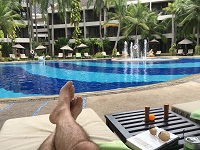(Total Views: 778)
Posted On: 08/01/2020 10:31:11 AM
Post# of 158031
Vicr,
Yes, more so when it is clear to all of us that CYDY thinks that progression times are important. And that we are being efective soon in the Mild indications. The blood work will "tell the tale" to the FDA so there is no doubt that Leronlimab works.
If they are presented with a plasma viral load going from XXX to YYY to ZZZ to 0 for days 0-3-7 and 14 respectively, are they going to say" look this does not work because some placebo got well also and also have small viral loads ???.". No because we will show the accelerated decrease of viral load is due to the drug .
Look what happened with GILD (which is treated much different, of course). They "found" that the hospitalization reduced from 15 to 11 days, not being the objective of their rial. Which did not meet the primary end point.
Please note that my concern with the p-value stems not from lack of effectivity of Leronlimab, rather by the inherent difficulty of demonstrating it with good statistics when we know that the majority of patents recover at day 14. I might be wrong on this, however have run several scenarios on my simulator and the more I enter recovered patients (in both groups @ day 14) the more difficult is to obtain a good p-value (of course, as this only compares the cohorts). If we were to perform the same exercise at say, day 6, another story would likely develop.
Quote:
There is still much be to be learned about COVID. I think the bloodwork and patient condition in this study will be of great value. So, a publication from the investigators involved will be important to the wider medical community. Maybe these bloodwork measurements will help to predict which milds progress to more serious disease? An obvious one might be DPs RANTES levels vs. time correlated to the health of the patient.
Yes, more so when it is clear to all of us that CYDY thinks that progression times are important. And that we are being efective soon in the Mild indications. The blood work will "tell the tale" to the FDA so there is no doubt that Leronlimab works.
If they are presented with a plasma viral load going from XXX to YYY to ZZZ to 0 for days 0-3-7 and 14 respectively, are they going to say" look this does not work because some placebo got well also and also have small viral loads ???.". No because we will show the accelerated decrease of viral load is due to the drug .
Look what happened with GILD (which is treated much different, of course). They "found" that the hospitalization reduced from 15 to 11 days, not being the objective of their rial. Which did not meet the primary end point.
Please note that my concern with the p-value stems not from lack of effectivity of Leronlimab, rather by the inherent difficulty of demonstrating it with good statistics when we know that the majority of patents recover at day 14. I might be wrong on this, however have run several scenarios on my simulator and the more I enter recovered patients (in both groups @ day 14) the more difficult is to obtain a good p-value (of course, as this only compares the cohorts). If we were to perform the same exercise at say, day 6, another story would likely develop.

